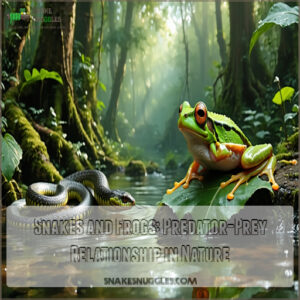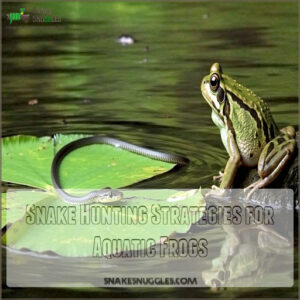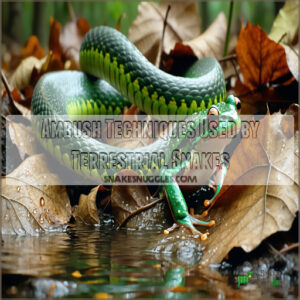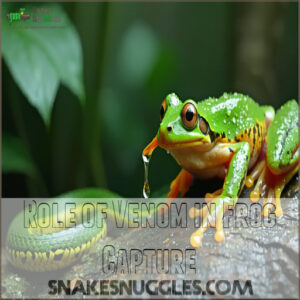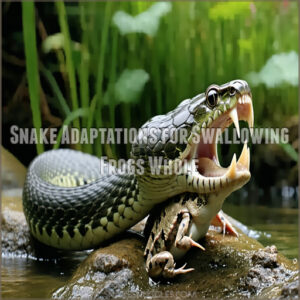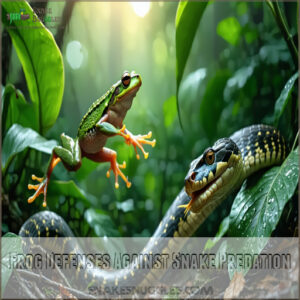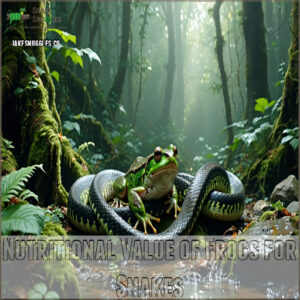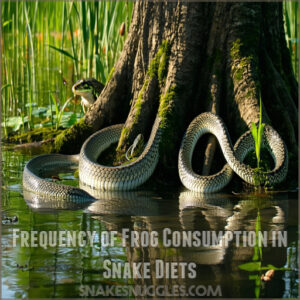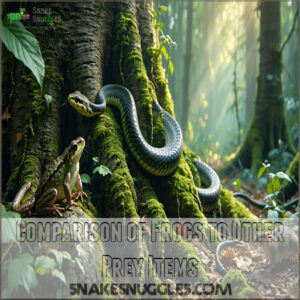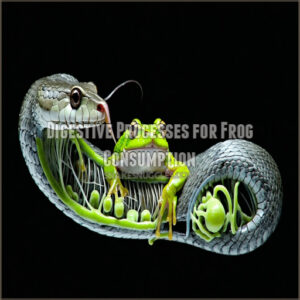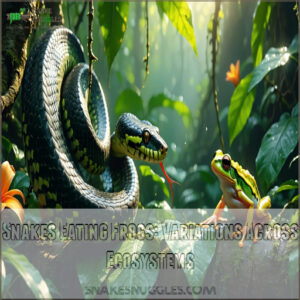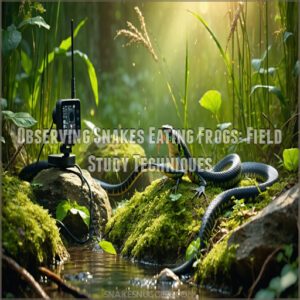This site is supported by our readers. We may earn a commission, at no cost to you, if you purchase through links.
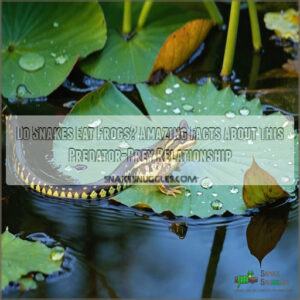 Yes, snakes do eat frogs, and this predator-prey relationship is an intriguing aspect of nature.
Yes, snakes do eat frogs, and this predator-prey relationship is an intriguing aspect of nature.
Certain snake species, like garter snakes and water snakes, commonly include frogs in their diet. Some snakes even specialize in hunting frogs, employing stealth, speed, and ambush tactics.
Frogs have their defenses, though—from toxic skin secretions to camouflage and agility.
This dynamic interaction between snakes and frogs varies across ecosystems and seasons, with spring migrations and summer heat influencing predation patterns. The fascinating details of this natural cat-and-mouse game reveal a delicate balance in the wild.
Table Of Contents
- Key Takeaways
- Snakes and Frogs: Predator-Prey Relationship in Nature
- How Do Snakes Hunt and Capture Frogs?
- Frog Defenses Against Snake Predation
- Snake Diet: Frogs as a Nutritional Source
- Snakes Eating Frogs: Variations Across Ecosystems
- Impact of Human Activities on Snake-Frog Interactions
- Observing Snakes Eating Frogs: Field Study Techniques
- Frequently Asked Questions (FAQs)
- Conclusion
Key Takeaways
- You’ll discover that snakes and frogs have a dynamic predator-prey relationship, where snakes hunt frogs using various techniques like ambush and venom, while frogs defend themselves with camouflage, toxins, and agility.
- You’ll find that different snake species have evolved specialized hunting strategies depending on their environment, from aquatic snakes using stealth to terrestrial snakes relying on ambush tactics.
- You’ll learn that frogs aren’t just a snack; they’re a nutritious food source for snakes, providing essential proteins and fats. However, human activities like habitat loss and climate change significantly impact these predator-prey interactions.
- You can contribute to snake and frog research through citizen science projects, helping scientists track snake movements, analyze their diets, and understand the ecological impact of these fascinating creatures.
Snakes and Frogs: Predator-Prey Relationship in Nature
You’ve probably wondered how snakes and frogs interact in the wild, and the answer lies in a fascinating predator-prey relationship.
Snakes rely on their unique adaptations to capture frogs, while frogs use clever defenses to avoid becoming a meal, showcasing a remarkable example of wild survival tactics.
Snake Species That Commonly Eat Frogs
In the context of frog predators, certain snake species stand out for their expertise.
Garter snakes, often spotted in backyards, love a good frog snack.
Water snakes hang out near ponds, making amphibian hunting easy.
Burmese Pythons? They’re heavyweight amphibian hunters.
Eastern Hognose Snakes even play dead to fool prey.
Many of these species are considered snake eating frogs experts in their natural habitats.
- Garter Snakes: Found across North America
- Water Snakes: Aquatic specialists
- Burmese Pythons: Powerful constrictors
- Ring-Necked Snakes: Small frog hunters
- Hognose Snakes: Masters of deception
Frog Species Most Vulnerable to Snake Predation
Brightly colored frogs or those lacking chemical defenses are prime targets for snakes eating frogs.
Vulnerable species, like small ground-dwellers, are often trapped by limited Frog Habitats.
Without agility or effective Predator Avoidance abilities, these frog species can’t outrun danger.
Snake Prey includes frogs that can’t rely on camouflage or defenses, making them easier victims in this predator-prey relationship.
Ecological Impact of Snake-Frog Interactions
Snakes and frogs are like nature’s checks and balances.
Snakes help keep frog populations in check, stopping overpopulation from disrupting the ecosystem balance.
Frogs, in turn, control insect numbers.
When frog decline hits due to habitat destruction or biodiversity loss, it impacts the entire food web — including the snake diet.
Protecting these predator-prey interactions supports healthy ecosystems and promotes frog conservation and snake conservation.
Understanding the concept of snakes eating frogs is essential for maintaining ecological balance and recognizing the importance of conservation efforts.
Seasonal Variations in Snake Predation on Frogs
During spring’s frog migration, snakes enjoy a buffet as breeding frogs flood wetlands, making for easy prey.
Summer heat shifts predator patterns: snake activity peaks, but clever frog species stay hidden.
Fall sees slower predator-prey encounters as environmental cycles shift, with frogs prepping for brumation.
Winter leaves both frogs and snakes scarce; snakes hunt other meals, illustrating how seasonal hunting perfectly explains the fluctuations in the ecosystem, which follows nature’s rhythm.
How Do Snakes Hunt and Capture Frogs?
You might be surprised by how skilled snakes are at hunting frogs, using strategies that depend on their environment.
Whether they’re ambushing frogs on land or striking underwater, snakes rely on stealth, speed, and sometimes venom to catch their slippery prey.
Snake Hunting Strategies for Aquatic Frogs
Imagine snakes as underwater ninjas, thriving in frog habitats with aquatic stealth and sharp instincts.
Snake hunting strategies rely on frog ambush, water stalking, and uncanny snake camouflage. They track prey through ripples and vibrations, mastering frog trapping techniques.
Effective snake hunters utilize proper snake hunting gear to increase their success rates.
- They strike lightning-fast.
- Ambush frogs near hiding spots.
- Pinpoint escape routes instinctively.
- Utilize underwater breathing pauses.
- Maximize efficiency in the snake diet battle.
Ambush Techniques Used by Terrestrial Snakes
Imagine this scenario: a snake, practically invisible among fallen leaves, relying on expert snake camouflage to pull off its next trick.
With sharp senses honed for covert stalking, it positions itself near damp spots where frogs hop unwittingly into danger.
Using ambush tactics, the snake’s lightning-fast strike leaves prey no chance to react.
This predator-prey showdown highlights nature’s ultimate game of stealth—where patience, stealth attacks, and precision define snake behavior during feeding.
Effective snake hunting requires the right hunting gear equipment to increase the chances of a successful catch.
Role of Venom in Frog Capture
Venomous snakes have perfected their frog-capturing techniques with venom as their ultimate asset.
This isn’t just a bite; it’s a tactical masterpiece.
Here’s how it works:
- Venom Delivery: Specialized fangs inject snake venom precisely.
- Neurotoxic Impact: Frogs’ movements are paralyzed quickly.
- Frog Toxins Neutralized: Some snakes resist frog toxins.
- Efficient Immobilization: Prey rarely escapes.
- Streamlined Capture Methods: Even larger frogs are subdued easily.
Understanding snake bite treatments is essential for handling such situations effectively.
Snake Adaptations for Swallowing Frogs Whole
Ever wonder how snakes pull off swallowing frogs whole?
Their adaptive jaws and flexible snake skull let their mouths stretch impressively wide.
With sharp teeth angled backward for a firm grip, they maneuver prey using clever body contortion.
The esophagus expands to handle frogs effortlessly, showcasing remarkable feeding behavior.
This predator-prey dynamic highlights why frog swallowing is a perfect feat in snake feeding adaptations!
Frog Defenses Against Snake Predation
You’d be amazed by the clever ways frogs outsmart hungry snakes. From toxic skin secretions to lightning-fast leaps, these defenses give frogs a fighting chance against their slithery predators.
Toxic Secretions and Their Effects on Snakes
Snakes don’t have it easy when chasing frog prey.
Frogs strike back with skin secretions packed with toxins or irritation-inducing compounds, some frogs even weaponize poison absorption, turning deadly to venomous snakes.
Yet, evolution plays its hand—certain snakes develop toxic resistance or venom immunity, letting them outsmart these defenses.
It’s nature’s intense predator-prey chess match!
Camouflage and Mimicry as Defensive Mechanisms
In the context of avoiding hungry snakes, frogs are the Houdinis of the wild.
Their adaptive camouflage and clever mimicry tactics make them masters of disguise.
Here’s how:
- Color change: Some frogs shift hues to match their surroundings.
- Pattern blending: Camouflaged skins mimic leaves or bark.
- Stealth movements: Freezing in place keeps predators guessing.
These frog defense tricks often outsmart snake behavior in the predator-prey game.
Escape Behaviors and Agility of Frogs
Research reveals that frog defense goes far beyond blending in – their agile movements can make the difference between life and death.
Adult frogs showcase remarkable amphibian speed, with some species moving three times faster than others during escape tactics.
You’ll notice their frog jumping precision varies by size: larger frogs rely more on powerful leaps, while smaller ones depend on frog camouflage .
| Escape Move | Success vs Snake | Energy Required |
|---|---|---|
| Spring Leap | 85% | High Impact |
| Freeze Still | 45% | Minimal Effort |
| Distance Hop | 78% | Medium Power |
| Water Dive | 92% | Quick Recovery |
Snake Diet: Frogs as a Nutritional Source
You’ll find that frogs aren’t just a snack for snakes – they’re actually packed with essential nutrients that help these reptiles thrive in their natural habitats.
When you look at a snake’s diet, you’ll notice that many species, from garter snakes to pythons, rely on frogs as a primary food source because they’re both abundant and easy to digest.
Nutritional Value of Frogs for Snakes
Just how nutritious are frogs for hungry snakes?
These amphibians pack quite a punch, with about 60% protein content on a dry basis.
Regarding frog nutrition and reptile nutrition, you’ll find they’re complete protein powerhouses, containing all essential amino acids that support snake digestion.
The energy value and nutrient absorption rates make them an efficient food source, with fats that fuel a snake’s daily activities.
While snake eating frogs is natural, pet owners should note that mice offer similar benefits without the parasite risks.
Frequency of Frog Consumption in Snake Diets
Through the lens of snake feeding habits, you’ll discover that frog consumption rates vary dramatically among different species.
Just like how we might crave different meals throughout the week, a snake’s prey preference isn’t fixed.
- Water snakes living near ponds show higher eating frequency, sometimes catching frogs several times weekly during peak seasons
- Dietary adaptation plays a key role – larger snakes might eat a bullfrog monthly, while smaller ones target tadpoles more frequently
- Temperature affects how often snakes eat frogs – they’re more active hunters during warm months
- Young snakes typically consume smaller frogs more often, sometimes twice weekly
- Environmental factors impact feeding patterns – snakes feeding on frogs may hunt less during dry spells when prey is scarce
You’ll find that each snake’s eating schedule is unique, shaped by their habitat, size, and local frog populations.
Comparison of Frogs to Other Prey Items
Prey preferences in nature’s food chain create an interesting menu hierarchy for snakes.
When comparing potential meals in their hunting tactics arsenal, these reptiles make surprisingly strategic choices.
- Rodents deliver more energy per bite than amphibian prey, making them premium energy sources for hungry hunters
- A frog’s quick escape moves demand more hunting effort compared to stalking slower prey
- Larger snakes naturally gravitate toward heftier meals, often skipping frogs entirely
- Small or young snakes find frogs perfectly sized for their abilities
- Frogs serve as reliable backup food when preferred prey becomes scarce
The combination of these factors influences the hunting tactics of snakes, showcasing their adaptability in the wild.
Digestive Processes for Frog Consumption
While frogs pack different nutrients than rodents, your typical snake’s digestive system is a marvel at breaking them down.
A balanced snake diet plan is essential for their health and well-being, and can be found at a balanced snake diet plan.
Here’s how snakes eat frogs with amazing efficiency, utilizing their unique biological features such as specialized enzymes and super-strong stomach acid.
- Their jaws unhinge completely, letting them swallow prey whole – even bullfrogs bigger than their head
- Specialized enzymes in the snake gut dissolve frog tissue 4x faster than human digestion
- Super-strong stomach acid breaks down bones and skin in under 24 hours
Snakes Eating Frogs: Variations Across Ecosystems
You’ll find fascinating differences in how snakes hunt frogs across the world’s ecosystems, from water snakes striking in wetlands to tree boas ambushing in rainforest canopies.
Whether you’re exploring a desert or wandering through a temperate forest, you’ll notice that each snake species has adapted unique hunting strategies that match their specific environment.
Tropical Rainforest Snake-Frog Interactions
Deep in tropical rainforest snake habitats, you’ll witness nature’s most intricate predator-prey dance.
Tree-dwelling constrictors like the Amazon Tree Boa masterfully navigate the forest floor ecology, using specialized heat-sensing pits to detect camouflaged amphibians.
These remarkable predators showcase the complex relationship where snakes eat frogs, while some prey species have evolved toxic defenses to resist venom, creating a fascinating example of tropical predator-prey adaptation.
Desert and Arid Region Snake Predation on Frogs
Across sandy dunes and parched landscapes, desert snake habits showcase nature’s remarkable adaptations.
These dry land hunting specialists have mastered survival in Earth’s harshest environments.
Here’s how sandy dune predators maintain their place in desert food chains:
- They use specialized heat-sensing pits to detect water-rich frogs, even in pitch darkness
- They time their hunts with brief rain periods when arid frog populations emerge
- They conserve energy between meals, surviving months without food
- They stake out temporary water sources, waiting to ambush prey
- They hunt nocturnally to beat the desert heat
Temperate Forest Snake-Frog Relationships
Within temperate forest ecology, snake-frog relationships unfold like a carefully choreographed dance.
You’ll discover how forest features shape predator-prey interactions through the seasons:
Survival Rate
Snake behavior and frog habitat preferences follow ancestral patterns, creating unique ecosystem balances in these temperate zones.
Aquatic Ecosystem Snake-Frog Dynamics
Silently and strategically, water snakes navigate aquatic environments, maintaining ecosystem balance through their predator-prey relationships with frogs.
You’ll find these remarkable hunters displaying both active foraging and ambush tactics, adapting their water snake behavior to match their prey’s patterns.
In aquatic food chains, larger snakes shift their diet toward frogs as they grow, creating dynamic predator prey interactions .
The survival of aquatic snakes depends on suitable freshwater habitats.
- Plain-bellied water snakes use quick reflexes to capture prey both in water and on land
- Banded water snakes thrive in diverse frog habitats from swamps to streams
- Northern water snakes excel at shallow-water snake prey capture
- Scale sensilla help aquatic snakes detect and strike at prey
Impact of Human Activities on Snake-Frog Interactions
You’ll find that your everyday activities, from building new homes to changing the climate, are reshaping how snakes hunt frogs in ways you mightn’t expect.
When you protect natural habitats and work to reduce pollution, you’re helping maintain the delicate balance between these predators and their prey, which involves delicate balance.
Habitat Loss and Fragmentation Effects
Recent studies show habitat destruction creates unexpected ripples in predator-prey relationships .
You’ll see this clearly in fragmented ecosystems, where construction projects and land development break up wildlife corridors that snakes and frogs need for survival.
Research reveals that predators often struggle more with habitat loss than their prey, disrupting natural species interactions that keep ecosystems in balance.
| Impact Level | Snake Effects | Frog Effects |
|---|---|---|
| Immediate | Lost hunting grounds | Breeding sites destroyed |
| Short-term | Population isolation | Reduced shelter options |
| Medium-term | Changed migration paths | Decreased food sources |
| Long-term | Genetic bottlenecks | Local extinctions |
Climate Change Influence on Predation Patterns
Temperature shifts now alter the dance between snakes and their frog prey.
As weather patterns intensify, predator-prey relationships face unprecedented challenges.
Climate modeling shows how ecosystem disruption affects when snakes eat frogs and their hunting success rates.
- Rising temperatures cause earlier snake emergence, changing traditional hunting cycles
- Altered rainfall impacts frog breeding, disrupting food availability
- Predator adaptation forces snakes to modify their hunting strategies
- Species interaction patterns shift as both creatures adjust their behaviors
Research reveals these changes ripple through entire ecosystems, affecting everything from snake eating bullfrog encounters to broader ecosystem conservation efforts.
Invasive Species Altering Snake-Frog Dynamics
Alien invaders are reshaping predator-prey relationships in your local wetlands.
Cane toads, notorious ecosystem disruptors, compete with native frogs for resources and can reduce their reproductive success by up to 86% .
You’ll notice how these invasive species force frog-eating snakes to adapt their hunting strategies or risk going hungry.
On small islands, these impacts hit even harder, as invasive species exploit broader ecological roles and trigger ripple effects throughout the food web.
Snake adaptation becomes essential for survival.
Conservation Efforts to Maintain Natural Balance
Wildlife conservation teams worldwide are making progress in protecting both snakes and frogs.
Riparian zones are essential for snake species, providing diverse habitats and resources.
You’ll see habitat preservation efforts spanning wetlands and forests, while species monitoring tracks population health.
Through biodiversity conservation initiatives, experts rebuild natural shelters, control non-native species, and study predator-prey relationships.
Local communities play a key role too, joining scientists to maintain ecological balance through education and research.
Understanding riparian snake interactions is essential for effective conservation.
Observing Snakes Eating Frogs: Field Study Techniques
You’ll discover how scientists use radio trackers and special cameras to study snakes hunting frogs in their natural habitats.
If you’re interested in contributing to this research, you can join citizen science projects that help researchers gather valuable data about snake-frog interactions in your local area.
Radio Telemetry for Tracking Snake Movements
You track snakes using radio telemetry, revealing their movement patterns.
Here are key benefits:
- Accurate tracking: via radio signals
- Minimally invasive: preserving natural behavior
- Valuable insights: into snake habitats and ecology, aiding wildlife conservation, especially for predator-prey relationships like snakes eat frogs.
Understanding snake behavior patterns is essential for effective conservation and research efforts.
Stomach Content Analysis of Wild Snakes
Snake digestion is a messy but fascinating process, and scientists are keen to uncover the dietary secrets of these wild reptiles.
By examining the gut contents of wild snakes, researchers can identify their recent meals and track seasonal eating patterns, which is like reading nature’s grocery list, revealing which frogs are on the menu and how often these amphibians become snake snacks.
This stomach analysis approach is a powerful tool for understanding wild snake diets and their ecological impact.
Citizen Science Contributions to Snake-Frog Research
You’re not just a nature enthusiast, you’re a citizen scientist! Your observations of snakes eating frogs in the wild are invaluable to researchers.
Through community engagement, you contribute to our understanding of snake ecology and reptile conservation.
Here’s how you can help:
- Report snake sightings, feeding behaviors, and habitat preferences through citizen science programs.
- Your data helps track patterns and expands our knowledge of predator-prey dynamics.
- This collaborative effort enhances species monitoring and informs research methods and data analysis.
Frequently Asked Questions (FAQs)
How do snakes eat their prey?
Most snakes swallow their prey whole, including frogs. Some snakes partially constrict their prey before eating, and a few venomous snakes use toxins to immobilize their meal first.
Do snakes eat frogs?
Snakes and frogs have a complex predator-prey relationship, and some snakes have even developed a taste for toxic toads.
It’s a wild world out there, and these sneaky snakes have a knack for finding their next meal.
Do pythons eat frogs?
Yes, pythons do eat frogs.
They’re opportunistic eaters with a varied diet, and frogs are on the menu, along with other small animals.
So, a python won’t say no to a froggy snack.
What do frogs eat?
Frogs feast on a buffet of insects, from juicy flies to crunchy beetles.
They’re nature’s pest controllers, gobbling up mosquitoes and keeping the ecosystem in check.
It’s a frog-eat-bug world out there!
Can snakes eat frog juice?
Sure, snakes can drink frog juice.
It’s a handy way to give captive snakes nutrients from frogs without the risks of live feeding.
This juice is scented to tempt snakes, helping them switch to other food sources.
Do ringneck snakes eat frogs?
Ringneck snakes do eat frogs, but they tend to go for the smaller ones.
They’ve got a trick up their sleeve, too – they can partially constrict their prey before chowing down.
What type of snake eats a frog?
A slithering array of snakes feast on frogs, from the deadly pit vipers of Asia to the sneaky night adders.
Garter snakes are also frog-eaters, along with the constricting ringneck and elephant trunk snakes.
Are snakes attracted to frogs?
Yes, snakes are attracted to frogs as a food source. They’ve evolved to hunt and eat them, developing unique characteristics like heat-sensing pits. Some even exploit toxins from venomous toads.
What do frogs get eaten by?
Frogs are on the menu for a range of predators, from snakes to birds.
Snakes, in particular, have a knack for sniffing out these amphibians, with some species specializing in frog-hunting.
Can a garden snake eat a frog?
Garden snakes, or common garter snakes, are known to eat frogs. These snakes are found across North America and are adaptable, often making homes near humans.
Conclusion
The wild is full of surprises, and the relationship between snakes and frogs is one intriguing dynamic.
Picture a sleek garter snake coiled by a pond, its eyes fixed on a plump frog.
In a flash, it strikes, and the frog becomes a meal.
Snakes do eat frogs, and this predator-prey dance is a delicate balance of nature.
From stealth hunting to toxic defenses, this relationship is a fascinating study in adaptation and survival.
So, the next time you spot a snake or a frog, remember the intricate web of life they’re woven into.
- https://pangovet.com/pet-behavior/snakes/do-snakes-eat-frogs/
- https://www.oriannesociety.org/faces-of-the-forest/what-do-frogs-and-salamanders-eat/?v=f69b47f43ce4
- https://www.livescience.com/27845-snakes.html
- https://www.sciencedirect.com/topics/pharmacology-toxicology-and-pharmaceutical-science/envenomation
- https://vcahospitals.com/know-your-pet/snakes-feeding

